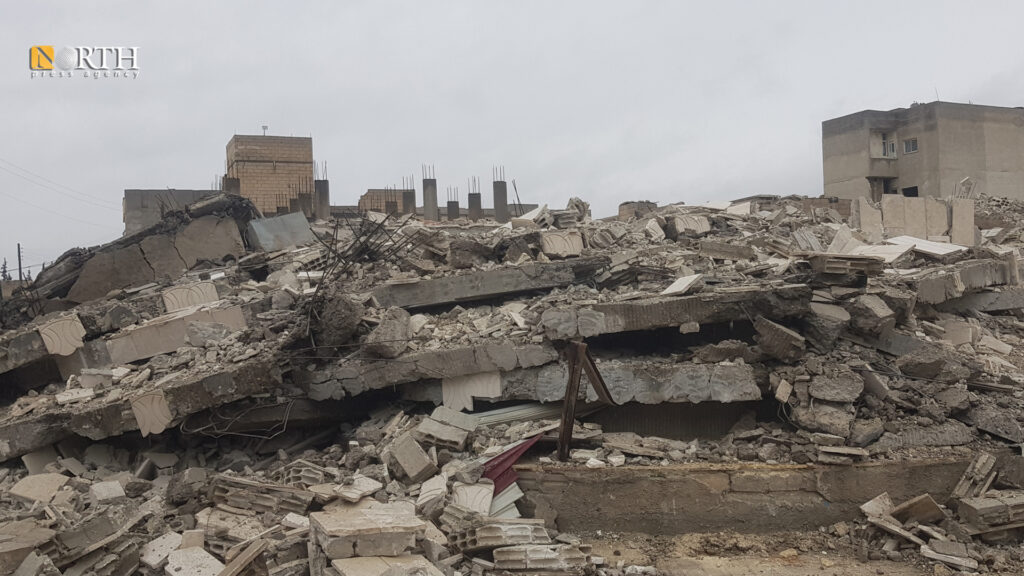Earthquake update: Syria’s Autonomous Administration
Situation
People in northern Syria are still daunted with fears of further aftershocks. They have been living outdoor on the streets and in their cars.
In the same direction, the Autonomous Administration of North and East Syria (AANES) installed 25 tents in its areas of control and equipped them with necessary needs to serve as accommodation centers. In camps, the situation has become more difficult, added to humanitarian and economic hardships.
Amid such a situation, Turkish forces shelled the city of Tel Rifaat and the Syrian Democratic Forces (SDF) arrested a leader of the Islamic State (ISIS) in Raqqa.

People left their houses and gathered in the countryside of Qamishli, NE Syria, for fear of aftershocks.
Gathering in the countryside of Qamishli for fears of aftershocks
Al-Hakomiya makeshift camp in Raqqa, north Syria.

Installing tents in Manbij in Aleppo eastern countryside, northern Syria
Humanitarian Situation
Hasakah
No damages were recorded in the city of Hasakah except for building cracks which could pose threats to its residents in case of any earthquakes or aftershocks or even military escalation. Most of the city locals left their homes fearing collapses.
People go out of their houses to the streets in Hasakah city, NE Syria for fear of aftershocks.
Qamishli
No destruction was recorded in the city of Qamishli. Damages were restricted to cracks in houses and buildings, pushing people to go to accommodation centers and outdoor. Many people went to the countryside or public squares in the city.

People of Qamishli city, NE Syria, leaving their houses and spending their nights in the tents for fear of aftershocks.
People of Qamishli city, NE Syria, left their houses to thestreets for fear of aftershocks.

People left their houses and gathered in the countryside of Qamishli, NE Syria, for fear of aftershocks.
Raqqa
The city did not witness any deaths or injuries. A building, however, collapsed and a part of an another building on al-Qitar Street fell down. The same happened to a balcony of a building close to Fire Department Square. In addition, a wall collapsed in the vicinity of Bara’em al-Mahaba kindergarten. Many houses and buildings sustained cracks.
Archaeological sites such as Raqqa Wall and Maiden’s Castle were damaged.
As other areas of northern Syria, people sheltered under tents in the countryside. Many of Raqqa buildings are already damaged and dilapidated since the time it was controlled by ISIS.
Peple of Raqqa city in north Syria left their houses and staying in tents set up in the parks by the AANES.

Peple of Raqqa city in north Syria left their houses for fear of aftershocks and staying in tents set up in the parks by the AANES.
Kobani
Six people were injured in Kobani. A number of buildings collapsed. A house in the village of Tel Hajeb in eastern Kobani and another in the village of Matin in southeastren Kobani collapsed. Another house was burned. Cars and buildings were either damaged or destroyed in Kobani whose people went outdoor fearing aftershocks.
The AANES in Kobani city, northern Syria, set up tents so that people can stay in after they left their houses for feat of aftershocks.

A building collapsed in Kobani as a result of Monday’s earthquake.
Manbij
Human losses remained the same in Manbij where two children and a man were injured. No new material damage has been recorded since yesterday, as a number of buildings were partially damaged. A number of cars, estimated at 15, received damage, too.
As many areas of northern Syria, locals in Manbij spent most of their times outdoor and in their cars. Some went to public square and others left to the countryside.
People of Manbij city in northern Syria spending time in their cars outside the city for fear of aftershocks.
Aleppo northern countryside (Shahba region)
No changes were recorded in Shahba region (the northern countryside of Aleppo) where three victims were reported. People took to the outdoor fearing further aftershocks or new earthquakes.
However, the area still undergoes shelling by the Turkish forces. On Monday, Tel Rifaat was shelled by Turkish forces.
People in the region said they welcome any newcomers. Shahba has been under siege by the Syrian government for three months.

Part of a mosque collapsed in Tel Rifaat town in Aleppo northern countryside, northwest Syria, as a result of Monday’s earthquake.
Sheikh Maqsoud and Ashrafiyeh in Aleppo
Six deaths and nearly 45 injuries were reported in both Aleppo neighborhoods. Balconies were partially destroyed. Many buildings sustained cracks.
Prior to the earthquake, a building collapsed in Sheikh Maqsoud claiming lives which doubled locals’ fears.
Part of a mosque in al-Ashrafiyeh neighborhood of Aleppo collapsed as a result of Monday’s earthquake.
Services and civil work
The Autonomous Administration of North and East Syria (AANES) voiced its readiness for any emergencies. It prepared medical staffs, fire and rescue teams to cope with any developments. However, the number of tents installed is short compared to the number of population that could leave their houses in case of any earthquakes.

Fire engines in the AANES-held city of Manbij, northern Syria.
Members of the Kurdish Red Crescent trying to warm up themselves by lighting fire in the open in Manbij, northern Syria.
Monitoring and Documentation Department

